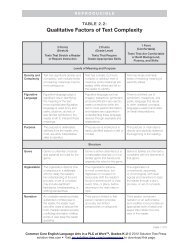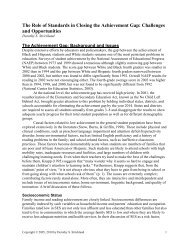Global Education Digest 2012 - International Reading Association
Global Education Digest 2012 - International Reading Association
Global Education Digest 2012 - International Reading Association
You also want an ePaper? Increase the reach of your titles
YUMPU automatically turns print PDFs into web optimized ePapers that Google loves.
SECTION 2 / Learning achievement: Differing policies and practices regarding grade repetition<br />
Africa had repetition rates exceeding 20%, compared<br />
to only 6 countries in 2009. In particular, the following<br />
countries have reduced their rates by more than 10<br />
percentage points: Cameroon, Congo, Ethiopia,<br />
Madagascar, Mozambique and Rwanda.<br />
However, primary education repetition rates remain<br />
very high in Burundi (36%), Togo (23%), Chad (23%),<br />
Central African Republic (23%) and Congo (23%).<br />
In contrast, rates are low in the United Republic of<br />
Tanzania (2%), Mauritius (3%), Ghana (4%), Ethiopia<br />
(4%) and Niger (4%). In Nigeria and Seychelles,<br />
the rates are nil due to the practice of automatic<br />
promotion.<br />
Across the region, boys are slightly more likely<br />
to repeat than girls. However, the gender gap<br />
widens in countries such as Lesotho, where 23%<br />
of boys repeat a primary grade compared to<br />
17% of girls. Male repetition rates at this level of<br />
education are about four percentage points higher<br />
than that of girls in Cape Verde, Lesotho, Namibia<br />
and Swaziland. However, the opposite is found<br />
in the Central African Republic, where 23% of<br />
girls enrolled in primary education repeat a grade<br />
compared to 22% of boys.<br />
Repetition rates for lower secondary education have<br />
also been falling across the region over the last<br />
decade. Yet, there is considerable variation at the<br />
country level, where these rates ranged between 2%<br />
in the United Republic of Tanzania to 30% in Burkina<br />
Faso in 2009.<br />
FIGURE 8<br />
How do trends in grade repetition and enrolment in lower secondary education<br />
compare across regions?<br />
Repeaters and enrolment in lower secondary education (general programmes) by region, 2000,<br />
2005 and 2010<br />
280<br />
304 310<br />
Enrolment Repeaters Percentage of repeaters<br />
200<br />
Enrolment (in millions)<br />
100<br />
0<br />
15<br />
13.8 13.6<br />
14.1<br />
15<br />
Repeaters (in millions)<br />
10<br />
5<br />
10<br />
5<br />
Percentage of repeaters<br />
0<br />
2000<br />
2005<br />
2010<br />
2000<br />
2005<br />
2010<br />
2000<br />
2005<br />
2010<br />
2000<br />
2005<br />
2010<br />
2000<br />
2005<br />
2010<br />
2000<br />
2005<br />
2010<br />
2000<br />
2005<br />
2010<br />
2000<br />
2005<br />
2010<br />
2000<br />
2005<br />
2010<br />
0<br />
WORLD<br />
Latin America<br />
and the<br />
Caribbean<br />
South and<br />
West Asia<br />
Sub-Saharan<br />
Africa<br />
Arab States<br />
North America<br />
and Western<br />
Europe<br />
East Asia<br />
and the<br />
Pacific<br />
Central and<br />
Eastern<br />
Europe<br />
Central Asia<br />
Note: Regions are ranked by the number of repeaters in 2010.<br />
Source: UNESCO Institute for Statistics database.<br />
22

















